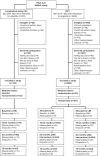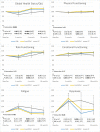Short- and long-term effect of high versus low-to-moderate intensity exercise to optimise health-related quality of life after oncological treatment-results from the Phys-Can project
- PMID: 35391574
- PMCID: PMC9135802
- DOI: 10.1007/s00520-022-07016-3
Short- and long-term effect of high versus low-to-moderate intensity exercise to optimise health-related quality of life after oncological treatment-results from the Phys-Can project
Abstract
Purpose: This study aimed to evaluate the effect of high intensity (HI) vs low-to-moderate intensity (LMI) exercise on health-related quality of life (HRQoL) up to 18 months after commencement of oncological treatment in patients with breast, colorectal or prostate cancer. In addition, we conducted a comparison with usual care (UC).
Methods: Patients scheduled for (neo)adjuvant oncological treatment (n = 577) were randomly assigned to 6 months of combined resistance and endurance training of HI or LMI. A longitudinal descriptive study (UC) included participants (n = 89) immediately before the RCT started. HRQoL was assessed by EORTC QLQ-C30 at baseline, 3, 6 and 18 months (1 year after completed exercise intervention) follow-up. Linear mixed models were used to study the groups over time.
Results: Directly after the intervention, HI scored significant (P = 0.02), but not clinically relevant, higher pain compared with LMI. No other significant difference in HRQoL was found between the exercise intensities over time. Clinically meaningful improvements in HRQoL over time were detected within both exercise intensities. We found favourable significant differences in HRQoL in both exercise intensities compared with UC over time.
Conclusion: This study adds to the strong evidence of positive effect of exercise and shows that exercise, regardless of intensity, can have beneficial effects on HRQoL during oncological treatment and also for a substantial time after completion of an exercise intervention. In this study, for one year after.
Implications for cancer survivors: Patients can be advised to exercise at either intensity level according to their personal preferences, and still benefit from both short-term and long-term improvements in HRQoL.
Keywords: Cancer; Exercise; HRQoL; Oncological treatment.
© 2022. The Author(s).
Conflict of interest statement
The authors no competing interests.
Figures


Similar articles
-
Long-term effectiveness and cost-effectiveness of high versus low-to-moderate intensity resistance and endurance exercise interventions among cancer survivors.J Cancer Surviv. 2018 Jun;12(3):417-429. doi: 10.1007/s11764-018-0681-0. Epub 2018 Mar 1. J Cancer Surviv. 2018. PMID: 29497963 Free PMC article. Clinical Trial.
-
Long-term resource utilisation and associated costs of exercise during (neo)adjuvant oncological treatment: the Phys-Can project.Acta Oncol. 2022 Jul;61(7):888-896. doi: 10.1080/0284186X.2022.2075238. Epub 2022 May 24. Acta Oncol. 2022. PMID: 35607981 Clinical Trial.
-
Cost-effectiveness of different exercise intensities during oncological treatment in the Phys-Can RCT.Acta Oncol. 2023 Apr;62(4):414-421. doi: 10.1080/0284186X.2023.2200149. Epub 2023 Apr 19. Acta Oncol. 2023. PMID: 37074759 Clinical Trial.
-
Exercise training undertaken by people within 12 months of lung resection for non-small cell lung cancer.Cochrane Database Syst Rev. 2019 Jun 17;6(6):CD009955. doi: 10.1002/14651858.CD009955.pub3. Cochrane Database Syst Rev. 2019. PMID: 31204439 Free PMC article.
-
Psychosocial interventions for preventing and treating depression in dialysis patients.Cochrane Database Syst Rev. 2019 Dec 2;12(12):CD004542. doi: 10.1002/14651858.CD004542.pub3. Cochrane Database Syst Rev. 2019. PMID: 31789430 Free PMC article.
Cited by
-
The Effect of Resistance and/or Aerobic Training on Quality of Life, Fitness, and Body Composition in Prostate Cancer Patients-A Systematic Review and Meta-Analysis.Cancers (Basel). 2024 Dec 23;16(24):4286. doi: 10.3390/cancers16244286. Cancers (Basel). 2024. PMID: 39766184 Free PMC article. Review.
-
Effect of Preoperative Home-Based Exercise Training on Quality of Life After Lung Cancer Surgery: A Multicenter Randomized Controlled Trial.Ann Surg Oncol. 2024 Feb;31(2):847-859. doi: 10.1245/s10434-023-14503-2. Epub 2023 Nov 7. Ann Surg Oncol. 2024. PMID: 37934383 Free PMC article. Clinical Trial.
-
The Impact and Molecular Mechanisms of Exercise in Cancer Therapy.Curr Issues Mol Biol. 2025 May 20;47(5):374. doi: 10.3390/cimb47050374. Curr Issues Mol Biol. 2025. PMID: 40699773 Free PMC article. Review.
-
Physical activity and pain in people with cancer: a systematic review and meta-analysis.Support Care Cancer. 2024 Feb 6;32(3):145. doi: 10.1007/s00520-024-08343-3. Support Care Cancer. 2024. PMID: 38321248 Free PMC article.
-
Experiences of rehabilitation one year after breast cancer diagnosis-A focus group study from the ReScreen randomized controlled trial.PLoS One. 2025 Feb 13;20(2):e0315814. doi: 10.1371/journal.pone.0315814. eCollection 2025. PLoS One. 2025. PMID: 39946344 Free PMC article. Clinical Trial.
References
-
- Stout NL, Silver JK, Raj VS, Rowland J, Gerber L, Cheville A, Ness KK, Radomski M, Nitkin R, Stubblefield MD, Morris GS, Acevedo A, Brandon Z, Braveman B, Cunningham S, Gilchrist L, Jones L, Padgett L, Wolf T, Winters-Stone K, Campbell G, Hendricks J, Perkin K, Chan L. Toward a National Initiative in Cancer Rehabilitation: Recommendations From a Subject Matter Expert Group. Arch Phys Med Rehabil. 2016;97(11):2006–2015. doi: 10.1016/j.apmr.2016.05.002. - DOI - PubMed
Publication types
MeSH terms
LinkOut - more resources
Full Text Sources

